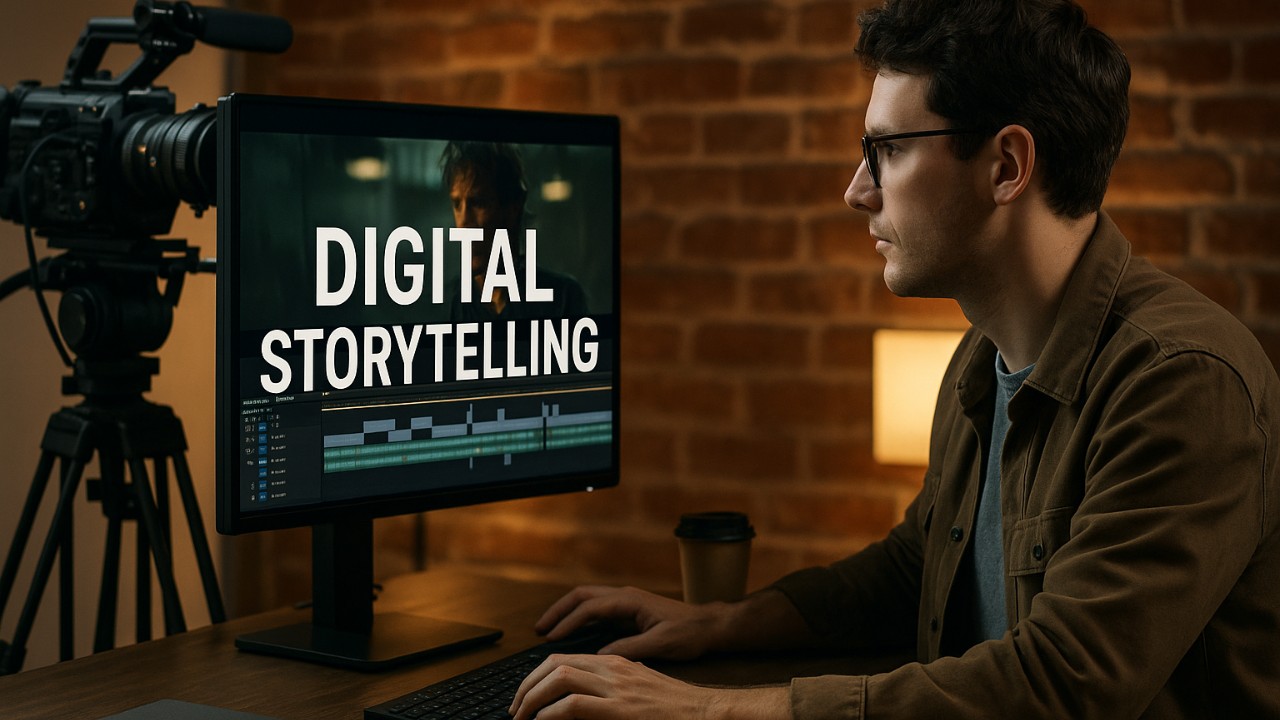The evolution of film-making has been deeply intertwined with technological advances, leading to the emergence of digital storytelling as a dominant narrative form. As of 2025, over 90% of films produced globally utilize some form of digital production or post-production, demonstrating a massive industry-wide shift from traditional methods. Digital storytelling has become central not just for directors and producers, but for everyone involved in the creative ecosystem, including students aspiring to build their careers in cinema.
Digital platforms like YouTube, Netflix, and Amazon Prime have opened new doors for storytelling formats, blending cinematic techniques with interactive technologies such as AR (Augmented Reality) and VR (Virtual Reality). According to a 2024 report by Statista, the global digital media market is expected to surpass $800 billion by 2026, a major part of which will be attributed to video and film-based content. In this changing landscape, understanding digital storytelling isn’t optional for film students — it’s critical.
Furthermore, film schools across the world, such as the New York Film Academy and FTII Pune, are revising their syllabi to incorporate digital storytelling modules. The shift highlights the importance of equipping students with the tools and techniques needed to craft narratives in a multi-platform world where audiences expect immersion, personalization, and innovation.
Understanding Digital Storytelling in Film-Making

Digital storytelling refers to the practice of using digital tools—such as video, graphics, sound, animation, and interactive media—to tell stories. It differs from traditional storytelling primarily in its medium and scope. Today’s audiences often consume stories across multiple screens, including phones, tablets, and virtual reality devices, demanding a more layered, dynamic narrative experience.
Core Components of Digital Storytelling
- Visual Narratives: Use of CGI (Computer-Generated Imagery), VFX, and digital cinematography.
- Interactive Elements: Choose-your-own-adventure styles, VR simulations.
- Data-Driven Personalization: AI suggesting story arcs or user-based content modification.
- Cross-Platform Engagement: Extending stories across film, web series, podcasts, and games.
Importance in Film-Making
The narrative is no longer confined to a two-hour theater screening. With OTT platforms and transmedia storytelling gaining momentum, digital storytelling makes it possible to extend and enrich the viewer’s experience across platforms.
Why Film Students Must Embrace Digital Storytelling
For film students, mastering digital storytelling isn’t just an academic exercise; it is a necessity for future-proofing their careers. Here’s why:
1. Expanding Creative Horizons
Digital mediums allow students to experiment with:
- Non-linear storytelling structures
- Integration of real-time audience feedback
- Hyper-realistic world-building using digital art
This flexibility leads to fresher, bolder content that resonates more powerfully with modern audiences.
2. Increasing Industry Demand
As per a 2024 survey by the Producers Guild of America, 75% of job postings in the film industry now require at least basic knowledge of digital editing software, animation, or VR/AR production. Students familiar with these tools will be highly sought after.
| Skills in Demand | Relevant Tools/Software |
|---|---|
| Digital Editing | Adobe Premiere Pro, DaVinci Resolve |
| CGI and VFX | Blender, Maya, After Effects |
| Interactive Storytelling | Unity, Unreal Engine |
3. Enhancing Audience Connection
Modern viewers expect dynamic and participatory experiences. Digital storytelling techniques allow filmmakers to:
- Create multiple story endings
- Develop character backstories through webisodes
- Offer interactive behind-the-scenes content
This deeper engagement often translates into stronger audience loyalty and wider reach.
Tools and Techniques Shaping Digital Storytelling
While creativity remains at the core, technical proficiency is vital for delivering a successful digital narrative.
Key Digital Tools
- Cinematography Tools: 4K/8K digital cameras like RED Epic and ARRI Alexa.
- Editing Software: Advanced suites that support 3D editing and virtual cinematography.
- Interactive Storytelling Platforms: Branching story platforms like Twine and Echo.
- Visual Effects Software: Software allowing deepfakes, digital doubles, and volumetric capture.
| Aspect | Leading Technology/Tool |
|---|---|
| Editing | Final Cut Pro, Avid Media Composer |
| Visual Effects | Houdini, Cinema 4D |
| Animation | Toon Boom, Blender |
Learning Strategy for Students
- Attend certified online courses.
- Intern with digital content production houses.
- Practice on smaller, independent projects before attempting larger productions.
Challenges Students May Face
While the advantages are significant, transitioning into digital storytelling comes with challenges for students:
1. Steep Learning Curve
Mastering sophisticated digital tools can be daunting without formal training. Film students must invest significant time outside regular coursework to build these skills.
2. Higher Production Costs
Advanced software licenses, digital equipment rentals, and post-production services can substantially increase costs for student projects.
3. Need for Interdisciplinary Knowledge
Students now need to blend knowledge from fields like computer science, animation, and even data analytics alongside traditional film theory and practice.
Practical Applications for Film Students
To truly harness the power of digital storytelling, students should explore practical applications:
- Short Films: Create short narratives utilizing CGI and AR effects.
- Web Series: Produce content specifically designed for digital consumption.
- Virtual Reality Experiences: Develop immersive stories where audiences can “walk” through a narrative.
- Social Media Films: Short, vertical-format films tailored for platforms like Instagram and TikTok.
Checklist for Students to Get Started:
- Learn basic and intermediate-level digital editing.
- Experiment with short-form interactive storytelling.
- Create a portfolio showcasing digital storytelling skills.
- Network with digital content creators and tech developers.
Digital storytelling is not merely an accessory to traditional film-making—it is becoming the language through which the next generation of stories will be told. For film students, adapting to this shift is not just beneficial; it is essential. As industry demands evolve and audience preferences shift towards more interactive, immersive experiences, those equipped with digital storytelling skills will not just survive—they will lead the future of global cinema.
Embracing digital storytelling empowers film students to innovate, engage, and connect with wider audiences in ways previously unimaginable. In a competitive and ever-evolving industry, being at the forefront of digital narrative technology will separate the future trailblazers from the rest.